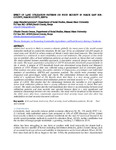| dc.description.abstract | Global food security is likely to remain a disaster globally for many years if the world cannot formulate methods to control the situation. By the year 2016, an estimated 120,000 people in rural areas and 30,000 in urban centers of Narok County were food insecure. This insecurity attributed to a mismatch in food availability, access and utilization. The purpose of this study was to establish effect of land utilization patterns on food security in Narok East sub-County. The study adopted human capability approach. A descriptive research design was adopted by the study. The target population comprised of 25078 households distributed proportionally in the 4 wards. A sample of 378 household heads was determined using Krejcie and Morgan’s formula of 1970. Primary data was collected using a questionnaire and an interview guide. Data analysis was done using descriptive statistics of frequencies, percentages and inferential statistics of correlation, ANOVA and regression analysis. The results were presented using frequency and percentages, tables and charts. The relationship between the variables was tested at a significant level of 5%. Results show that there is a very strong positive and significant correlation between land utilization patterns and food security (r = .752** and a p- value of 0.000). This implies that the relationship between the variables is very significant hence land utilization patterns have a strong influence on food security in Narok East sub-County. The study concludes that the null hypothesis that there is no relationship between land utilization patterns and food security was rejected because there is a very significant and statistical relationship between the two variables. The study will be beneficial to the farmers in the ASAL areas who have consistently experienced food security issues and also other key stakeholders in food security discourse in Kenya. | en_US |

